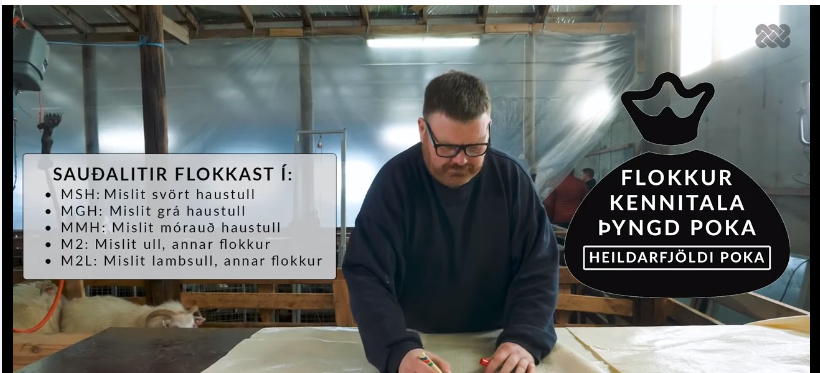About Icelandic wool
What Makes Icelandic Wool Special?
Icelandic wool is unique due to its dual-layered structure: tog = coarse, long outer fibers that are water-resistant; and þel = soft, fine inner fibers that provide insulation. These layers can be separated and used for different types of yarn. Icelandic sheep are typically shorn twice a year. Autumn (Oct–Nov): High-quality wool, clean with long fibers. Spring (Feb–Apr): Coarser, oilier wool often used as filler or for non-wovens. Most wool is sold to the Ístex factory, with farmers shearing themselves or hiring shearers. See also: istexwool.is/home/icelandic-sheep/
Wool Categories
Wool is sorted by season, color, age, and quality. Main types include:
H: White wool (spring & autumn)
M: Multicolored wool (spring & autumn)
L: Lamb’s wool (spring & autumn)
V: Winter wool (spring only)
Each is further graded (e.g., H2, H3) based on quality. Full classification chart: ullarmat.is/wp-content/uploads/2020/09/Ullarflokkun-2020.pdf
- Single colour (white, grey, black, brown) in first class quality = clean and free of any impurities. In 2026, 1kg. of 1st class white lambswool from autumn shearing - the most valuable category - pays around 613 ISK (payment from Ístex, see price list here). In comparison, 1kg of 2nd class white sheep wool pays 438 ISK; M2 multicoloured wool = 0 ISK. The best wool is used for yarn production; there tends to be more demand than supply. Less valuable categories are exported and used e.g. for making carpets. (See also: https://www.bbl.is/frettir/fraedsluhornid/stada-i-ullarmalum-vegna-covid-19).
Least profitable categories
- Autumn wool: H 2, H 3 og M 2. White and multicoloured wool of lesser quality. M stands for multicoloured (Icel. "mislit") wool from brown / brindle sheep, or any other mixed colour. The roughest bits of wool, such as the "tog" (outer layer) from a sheep's leg, are categorised as third class and have no value.
- Winter wool: Wool shorn in February / March. The wool from sheep fed outside during the winter months tends to be dirtier and contains traces of hay. It is also oilier, since winter wool has a higher Lanolin content than autumn wool does. See also: ullarmat.is/ullarflokkar/hvit-vetrarull/ og ullarmat.is/ullarflokkar/saudalitir-vetraull/
Unprocessed wool
Wool that has not been spun yet. May have been washed and carded; washed and / or carded wool is still considered unprocessed wool.
The Wool Life Cycle:
